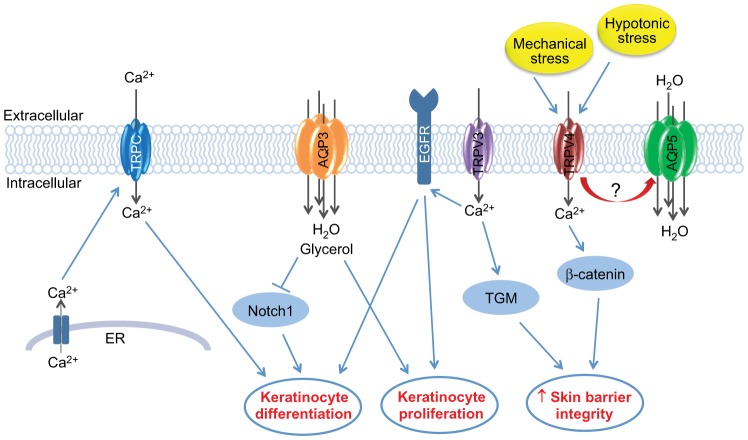Fig. 2.
Illustration of the role of key aquaporin and TRP channel proteins in formation of the epidermal barrier. TRP channels form tetrameric cation-permeable pores, which allow the movement of a variety of cations, including Ca2+, which is crucial for the regulation of keratinocyte differentiation. A number of TRPC channels (blue) are expressed in keratinocytes, and there is evidence supporting a key role for these channels in the promotion of Ca2+-induced keratinocyte differentiation. TRPC channels are believed to be activated (thus allowing the influx of extracellular Ca2+) upon detection of Ca2+ release from internal stores, such as the ER. TRPV3 (purple) appears to play a central role in keratinocyte biology, with a key role in establishing the balance between keratinocyte proliferation and differentiation, which is believed to be mediated through EGFR activation. TRPV3 might also have a more direct role in the formation of the epidermal barrier through regulation of the activity of transglutaminases (TGM), the enzymes required for the cross-linking of protein components of the cornified envelope. Furthermore, TRPV4 (red), which is activated in response to mechanical and hypotonic stress, has been shown to bind to components of the intercellular junctions, such as β-catenin, leading to increased skin barrier integrity. AQP3 (orange), an aquaglyceroporin that is abundantly expressed in keratinocytes, also allows the movement of small molecules, such as glycerol, in addition to water, into keratinocytes. AQP3 appears to play a central role in keratinocyte proliferation, and although the role for AQP3 in keratinocyte differentiation is less clear, there is evidence that it might be involved in the negative regulation of differentiation through inhibition of Notch1, a known mediator of keratinocyte differentiation. AQP5 is a water-selective aquaporin, the role of which in the formation of the epidermal barrier is currently unclear. However, AQP5 (green) might have a role in the regulation of cell–cell adhesion, either through microtubule stabilisation or through an association with TRPV4, as has been shown in other cell types, but further work is required to determine this.

